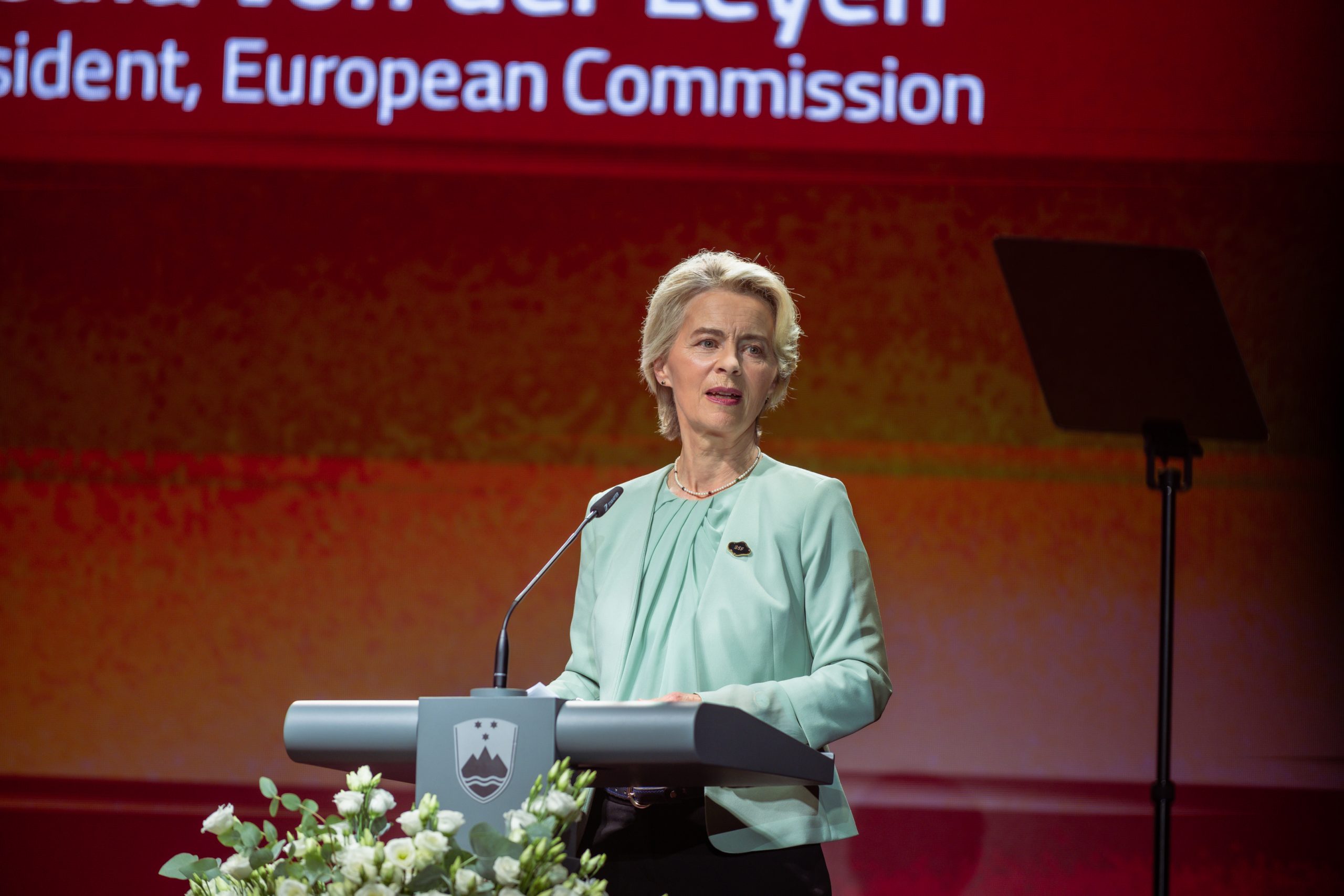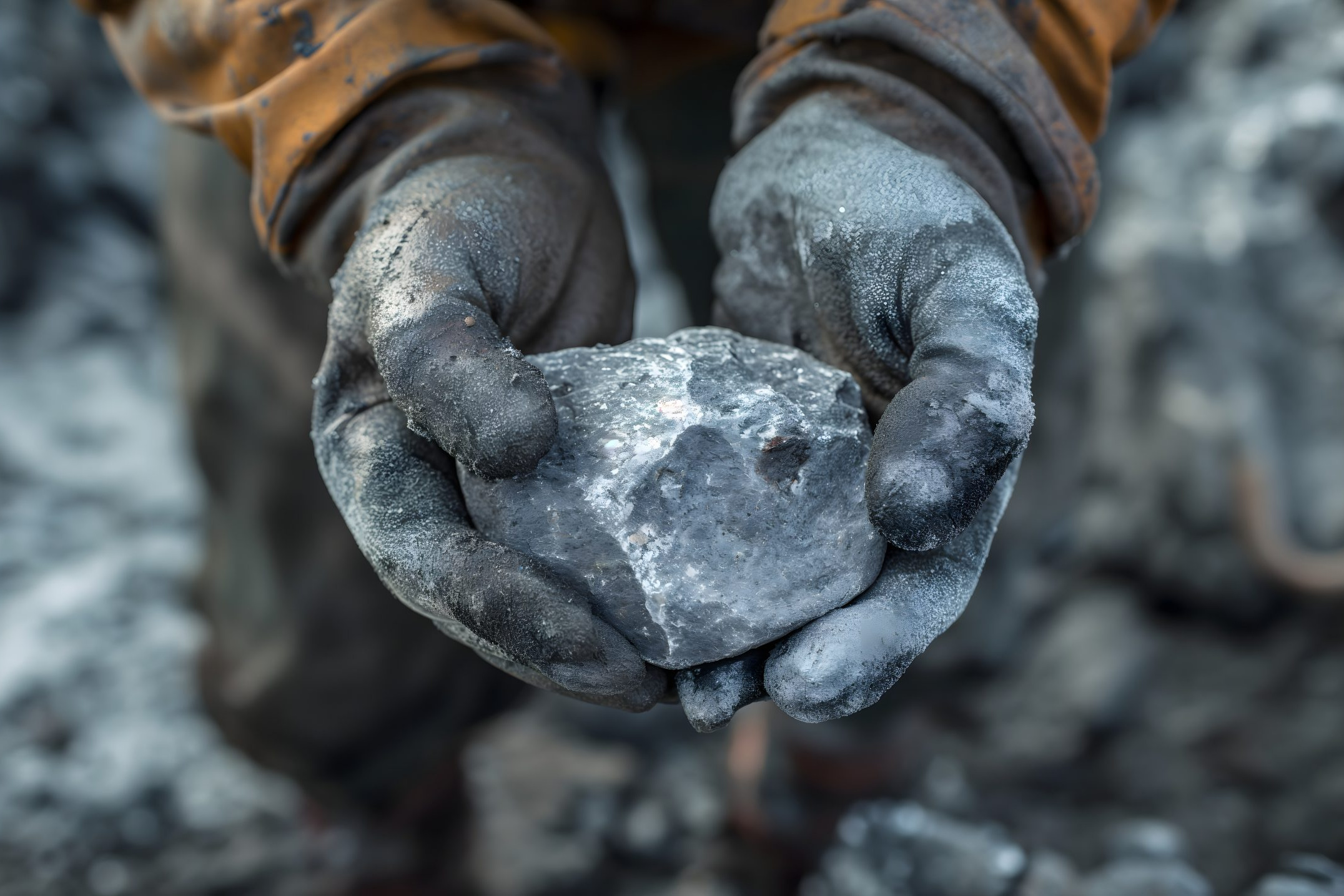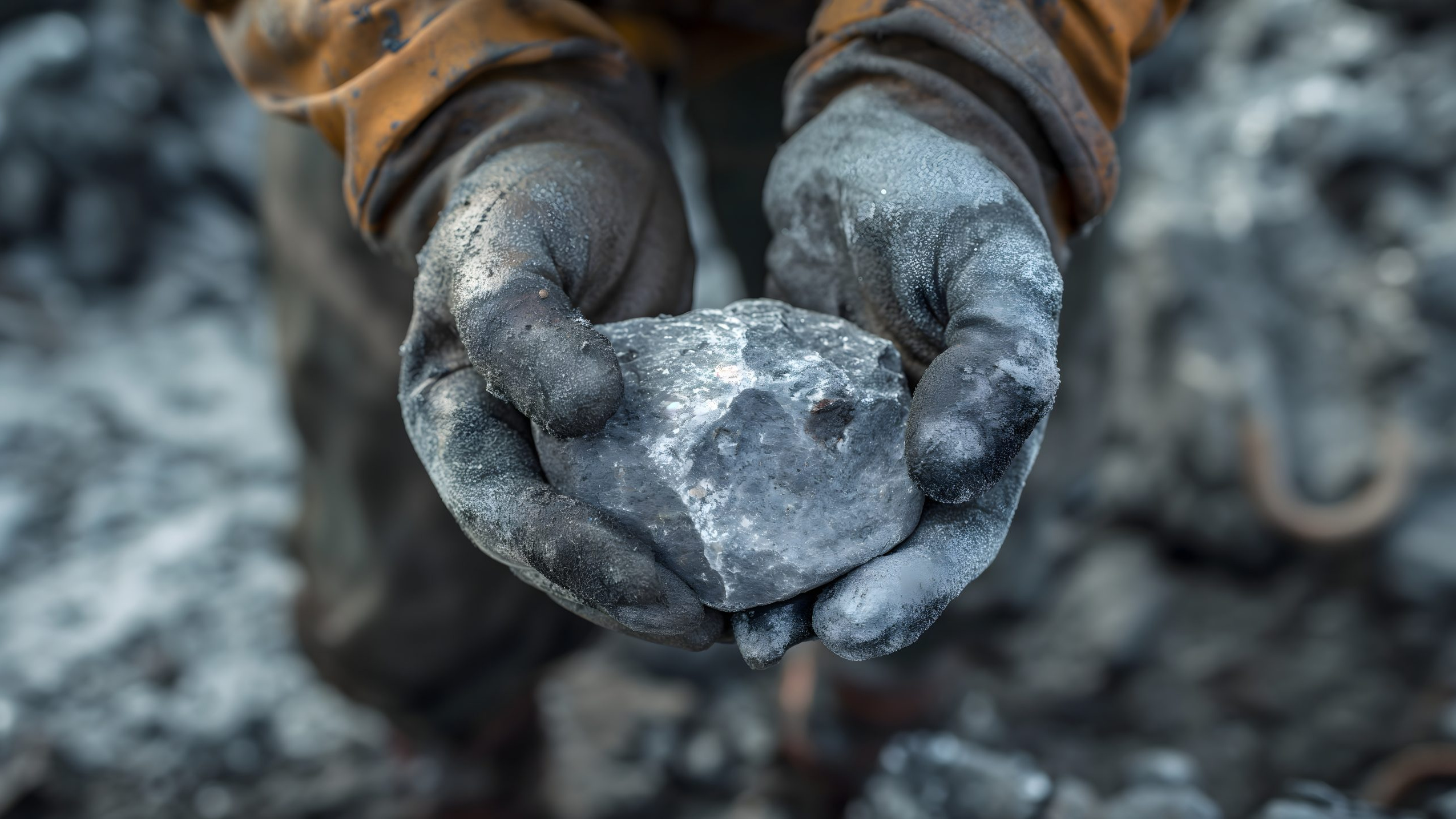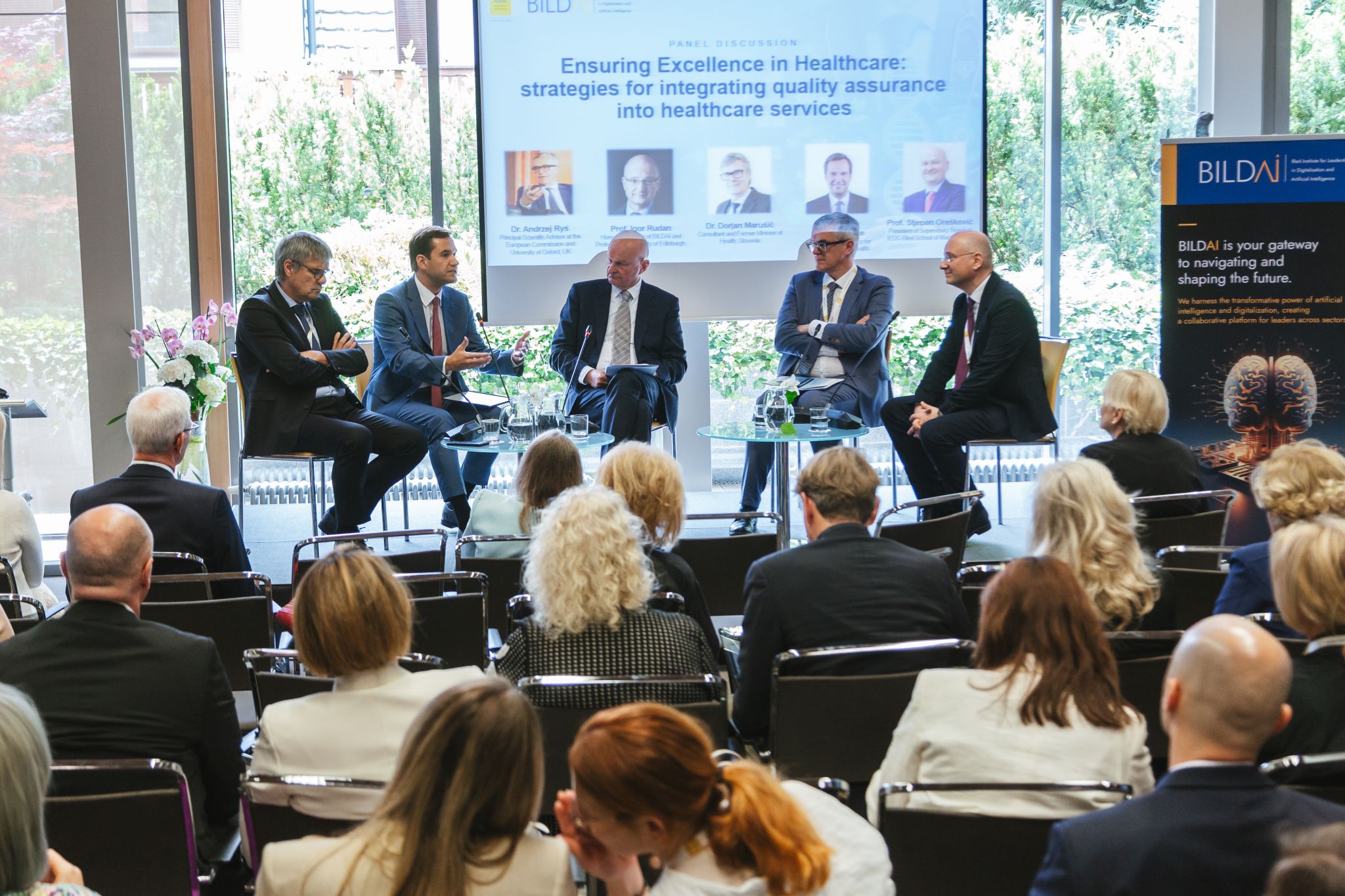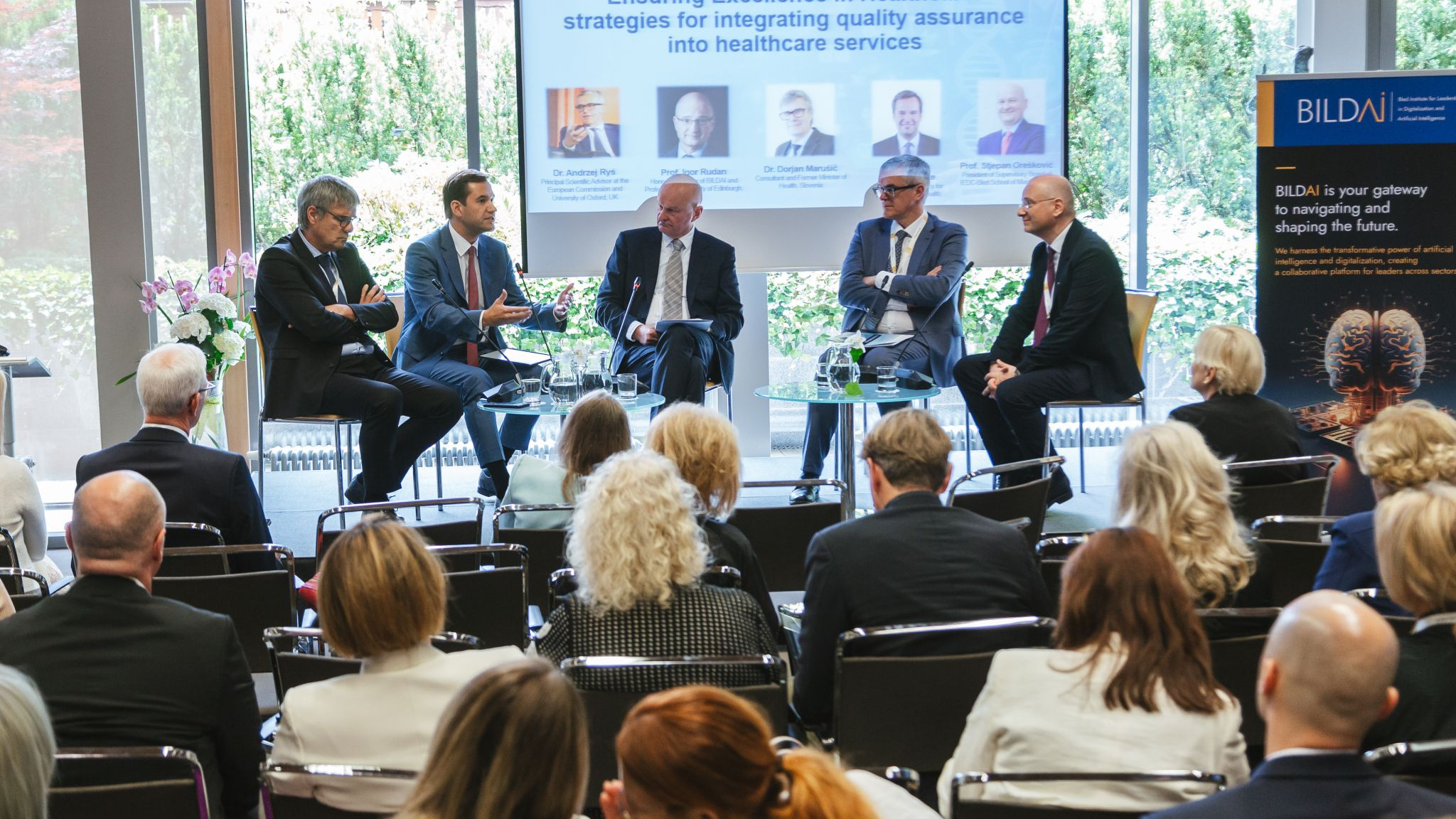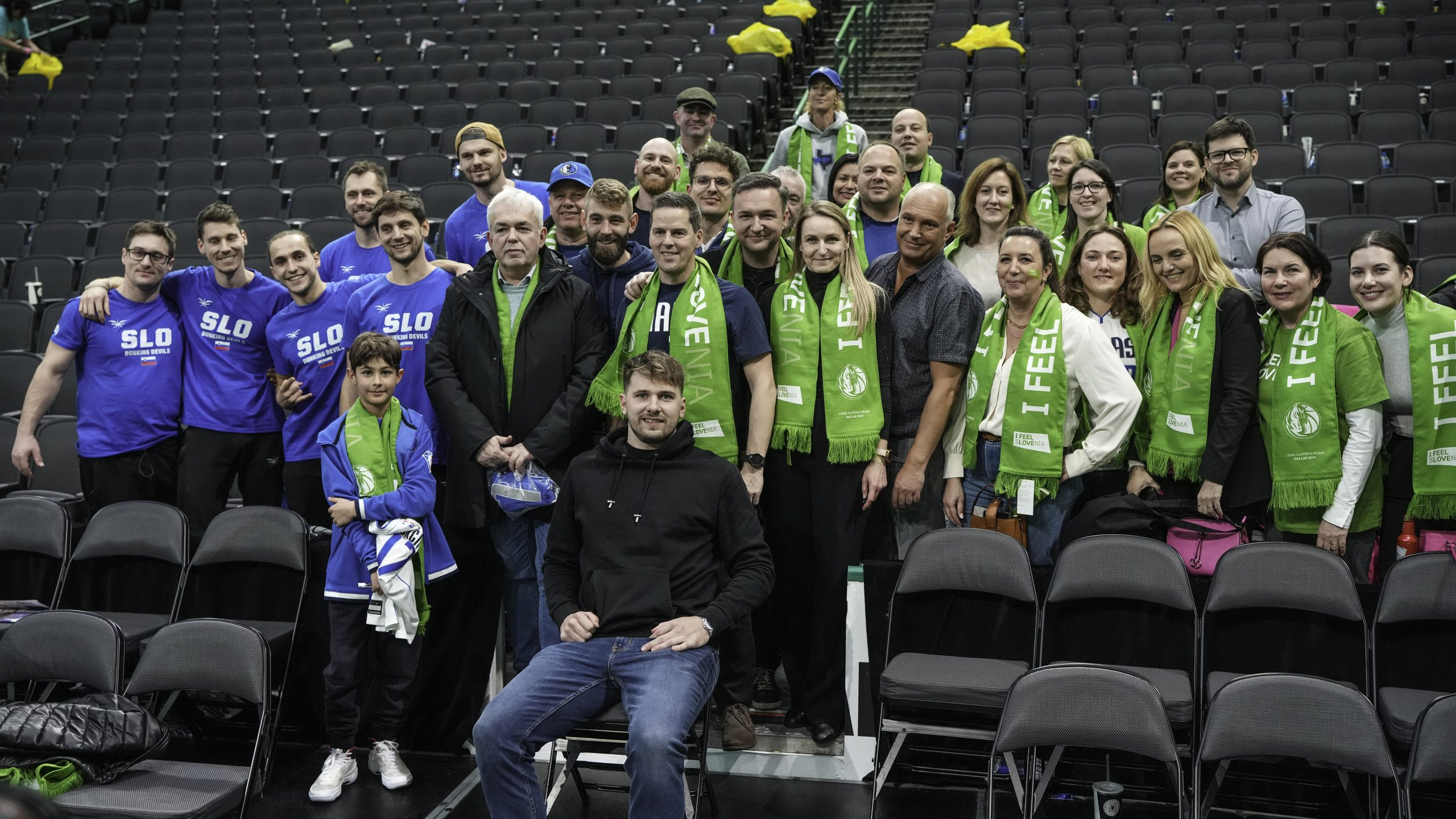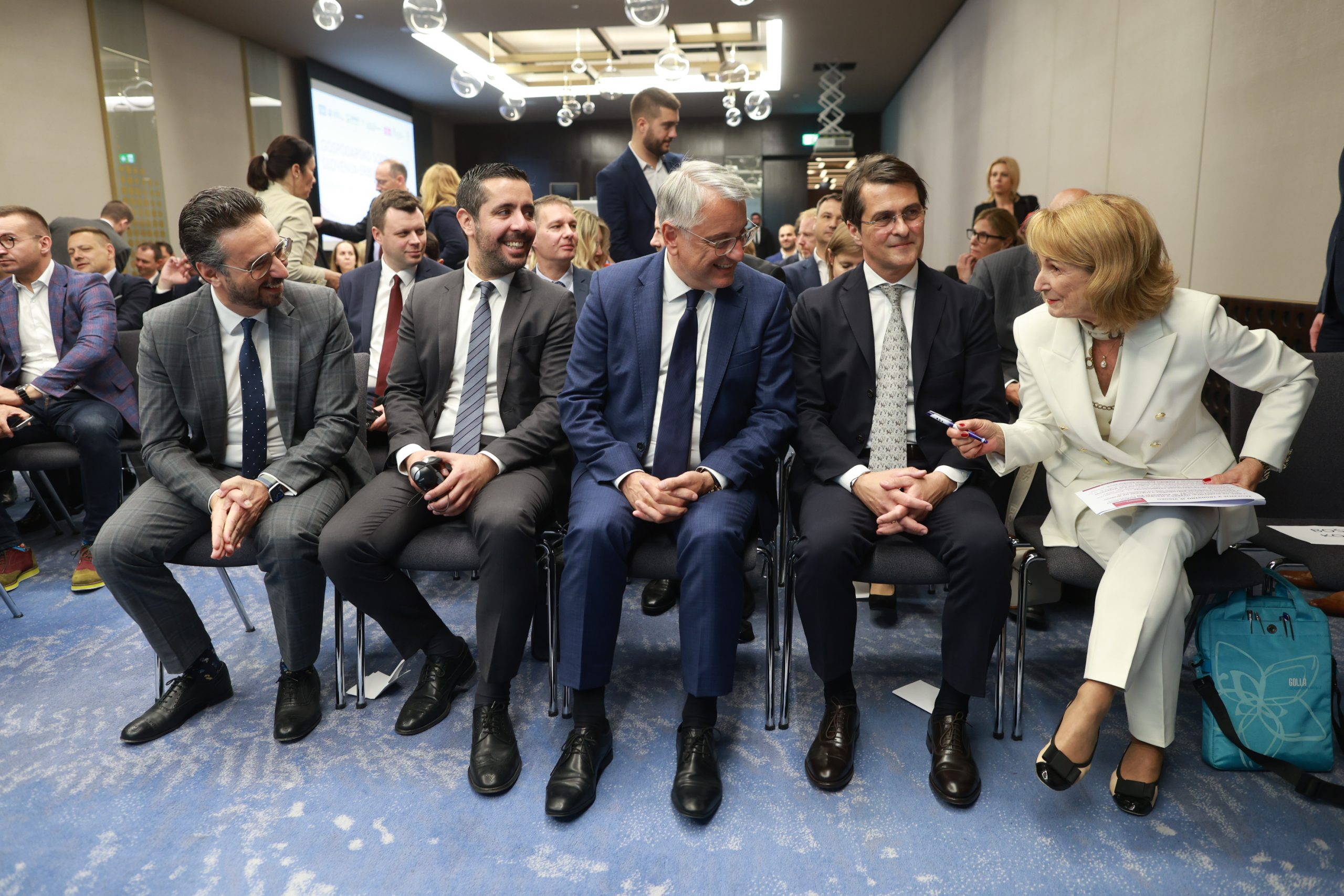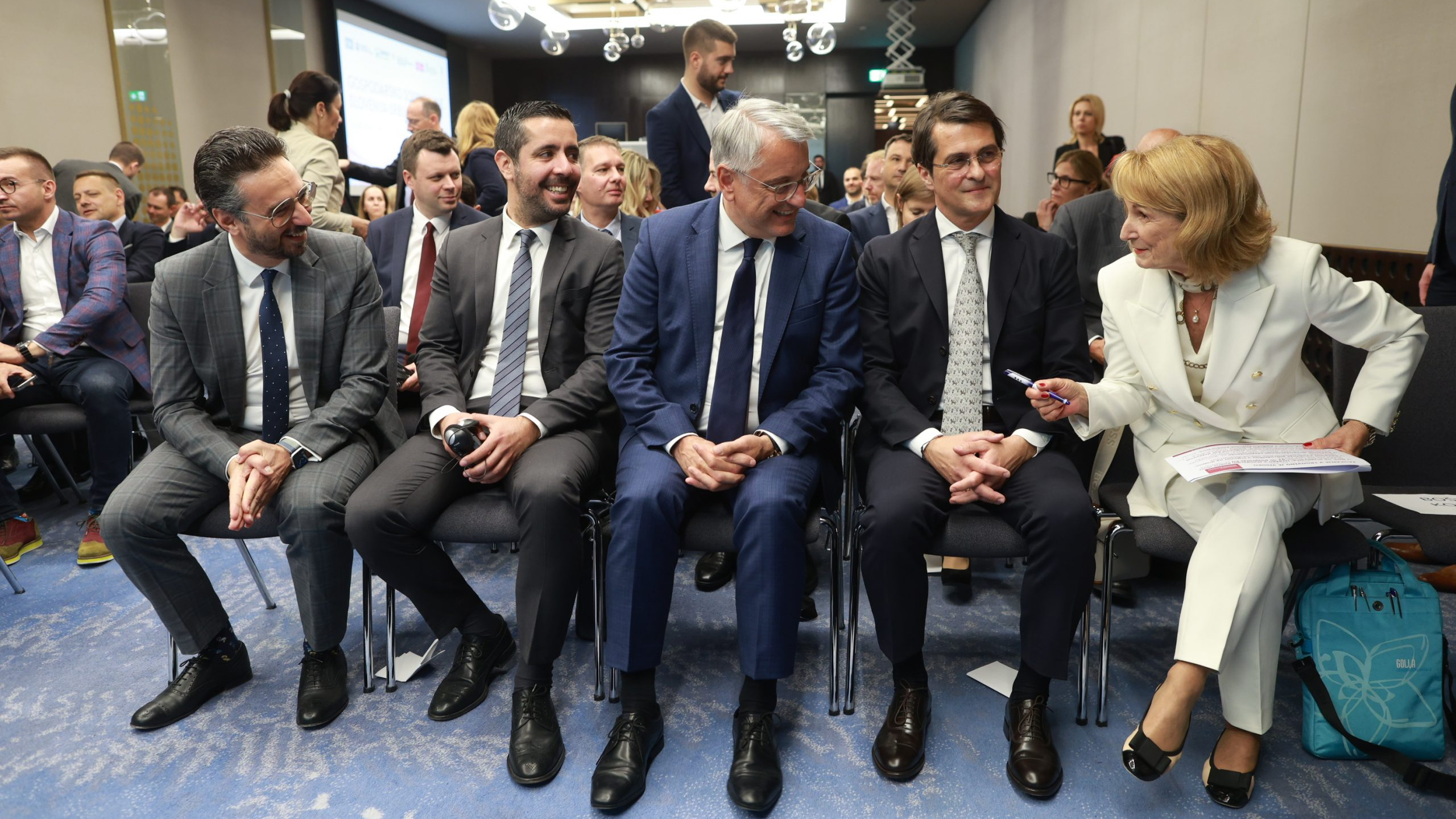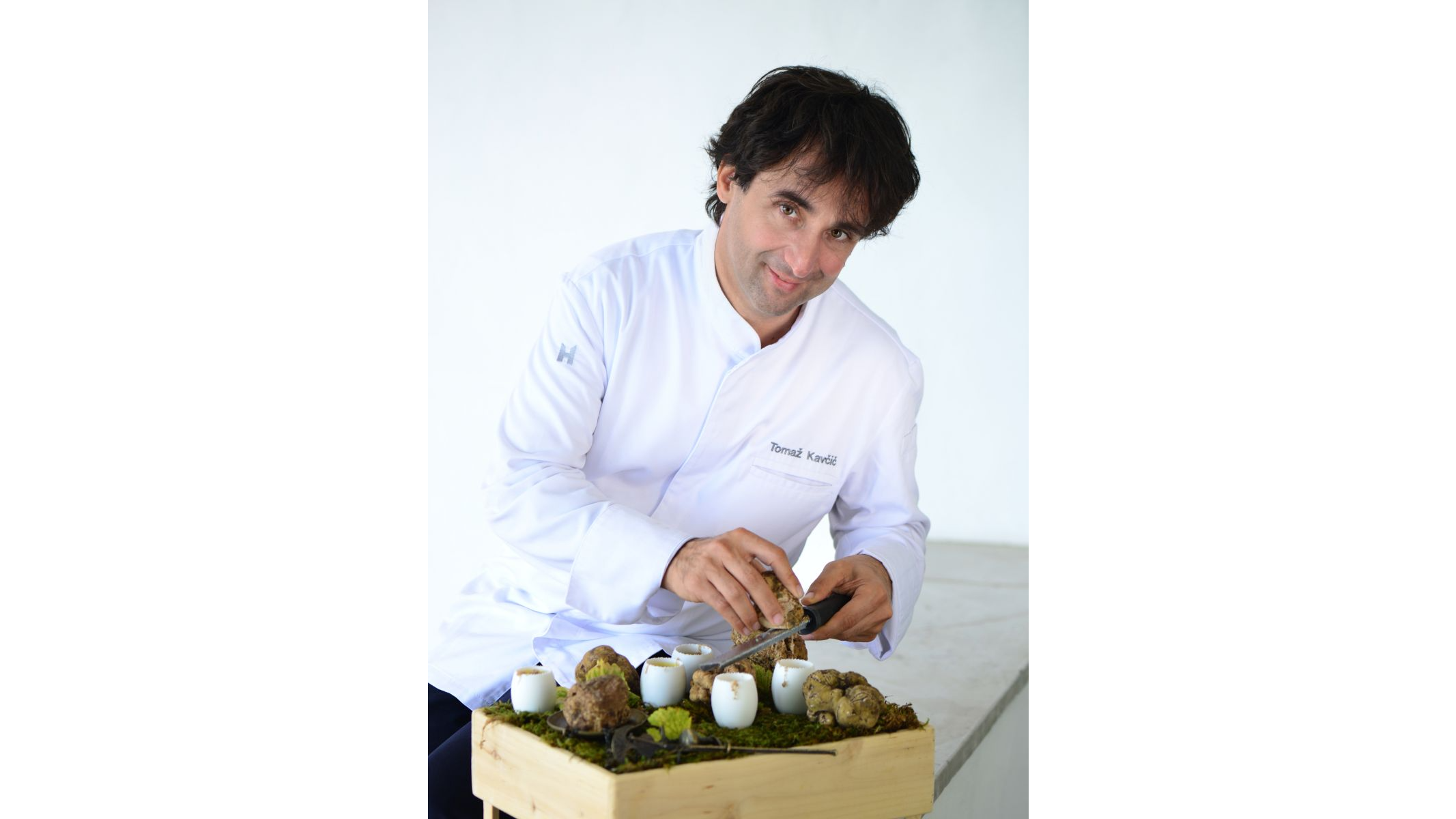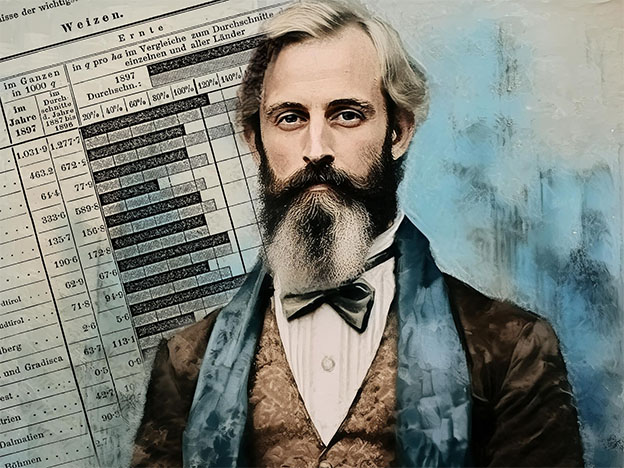Adriatic stirring pots reveal national character
editor
Jure Stojan
In the Adriatic region, cooking shows have transcended their traditional role as mere culinary exhibitions, becoming vibrant reflections of national culture and identity. To use Massimo Montanari's wise words, the 'taste of geography' doesn't belong to the past."
In Serbia, “Majke i Snajke” (Mothers and Daughters-in-Law) illustrates this concept vividly. On the surface, it is a culinary duel of women vying for favour of the son/husband. Deep down, it is a tableau of traditional family dynamics and the societal importance of domestic culinary skills. This show is not just a contest; it is a cultural commentary, weaving family relationships into the fabric of national identity, embodying the Serbian values of familial bonds and the revered status of culinary expertise.
Contrastingly, Croatia’s “Tri dva jedan – kuhaj!” (Three Two One – Cook!) spotlights a different facet of national character. The show’s evolution is striking, as noted by producer Danijela Habek, who speaks of a “return to roots” in recent seasons, simplifying the contest of competing pairs structure to enhance the culinary challenge. This mirrors the Croatian ethos of community and collaboration. Judge Ivan Pažanin’s description of the show as a “real gastro competition” with a focus on professional cooking and a wide culinary range, from traditional Croatian dishes to global cuisines, underscores this communal spirit.
A taste of heritage
Meanwhile, in Bosnia, “Moj chef je bolji od tvog” (My Chef is Better than Yours) aims to display “the flavours inherited by the people of Bosnia and Herzegovina”. To quote the advertisement for the programme, “the most beautiful flavors are created from love and the need to relax.”
These shows, in their unique ways, serve as a cultural lexicon. They offer a window into societal values, traditions, and the evolving nature of national identities in the Adriatic. They are platforms for showcasing culinary excellence and mirrors reflecting the diversity, complexity, and richness of the region’s cultural landscape.
Moreover, these programs resonate with Carole Counihan’s observation that “Food is a product and mirror of the organization of society on both the broadest and most intimate levels. It is connected to many kinds of behaviour and is endlessly meaningful. Food is a prism that absorbs and reflects a host of cultural phenomena.” In Serbia, “Majke i Snajke”reinforces traditional gender roles through its format, while in Croatia, “Tri dva jedan – kuhaj!” challenges these norms by emphasizing collective culinary endeavours over individual prowess.

Photo: Hayat/Youtube
The culinary themes and recipes featured in these shows also offer insights into the historical and geographical influences shaping national cuisines. For instance, the emphasis on hearty, comfort foods in Serbian cooking shows reflects the importance of communal meals in its social fabric. Croatian shows often feature seafood and Mediterranean flavours, highlighting the country’s geographical location and historical ties with Mediterranean and Central European culinary traditions.
These cooking shows are more than entertainment; they are a narrative of nations. As they continue to evolve, they will undoubtedly serve as key indicators of societal changes and cultural continuities, offering a unique perspective on the nations they represent. They do more than just satiate the appetite; they nourish cultural curiosity and foster a deeper understanding of the rich tapestry that is the Adriatic region.
In conclusion, the cooking shows of the Adriatic region are a testament to the power of cuisine as a cultural identifier. They are a celebration of national heritage, a reflection of societal values, and a vibrant medium through which the story of a nation is told, bite by delicious bite.
THE ADRIATIC
This article was originally published in The Adriatic 2024 printed version
Sub-zero delight
editor
On a holiday, waiting in line for an ice cream? A queue of our times…It’s almost part of the holiday itinerary: breakfast, beach, lunch, beach, dinner, and finally, joining the line to get that refreshing scoop of your favourite flavour. You know the drill: you’ve checked Tripadvisor and found that top-rated local gelateria. And for the taste of it, you will wait. You’re in no rush anyway.
It’s July, so it’s only right to turn our attention to ice creams. One of our favourite treats has been around for thousands of years. As far back as 500BC, the Persians are believed to have created an early version by mixing snow with grape juice and other flavours. In the Roman empire, Nero sent slaves to collect snow from the mountains to mix with honey and wine, while the Tang Dynasty in China developed a creamy mix made from buffalo milk, flour, and camphor.
Then, in the 17th century, the French introduced the milk-based ice creams as we know them today. By the 18th century, ice cream had made its way to America, where it rapidly gained popularity. With the invention of cone in the mid-19th centry, the ice cream was set for global dominance.
Today, the biggest consumers of the frozen delight are not Americans as popularly believed – it’s New Zealanders. Huge fans, an average Kiwi consumes over 28kg of ice cream per year! In our region, Croats top the table with 7.5kg per person, with Serbs consuming 5kg, and Slovenians and Bosnians just under 4kg.
Flavours to savour
While vanilla still reigns supreme as the most popular flavour in many countries, followed closely by chocolate, our taste buds have altered in recent times and, frankly, we are spoiled for choice. Ice cream makers have created and continue to create some truly unique and unusual flavours: avocado, garlic, chili, Stilton cheese, bacon, asparagus, even oysters!

Photo: Aroma Global
Those might not be up your street but flavours, such as those created by Aroma Global, Slovenian-owned ice cream brand with production in Croatia, are much more appealing: hazelnut, caramel with sea salt, mango, pistachio, dark chocolate, raspberry, to name but a few. The company’s founder and majority owner Primož Ogrizek proudly explains that the ingredients in their aROMA gelato are natural and sourced from various parts of the world: pistachios from the Bronte region in Sicily, Piedmont hazelnuts, Madagascar vanilla, raspberries from Arilje in Serbia, Alphonso mangoes from India, and exclusively local fresh milk, cream, and yogurt. They company uses fresh fruit, cold-pressed citrus, and fresh herbs such as basil, mint, and rosemary to ensure that aROMA’s gelato stands out, Ogrizek adds. What is more, they also have specialised flavours such as Fior Di Latte with olive oil, teranino, and lavender with lemon, adding a local touch in their offering.
Amongst the more than 50 produced flavours by the company, it is pistachio that tops the popularity in their 57 boutiques across Croatia. Our guess is it’s probably worth a try.
In the queue yet?

THE ADRIATIC
Europe eyes Balkan potential to secure rare metals future
editor
Maja Dragovic
As the global race for critical raw materials intensifies, the Western Balkans is emerging as a potential key player in Europe's quest for rare earth elements (REEs) - crucial components in modern technology and the green transition. The European Union, currently reliant on China for over 95% of its REE supply, is actively seeking ways to bolster its self-sufficiency. Recent studies and exploration efforts have unveiled significant REE potential across the Balkan region, catching the attention of both EU policymakers and mining companies.
At the forefront of this new drive is Serbia’s Jadar project, led by mining giant Rio Tinto. The project, which was previously halted due to environmental concerns, is now back on the table. Serbian President Aleksandar Vučić recently indicated that the government is preparing to give Rio Tinto the green light to develop what could become Europe’s largest lithium mine. The project is estimated to produce 58,000 tons of lithium per year, potentially meeting 17% of Europe’s electric vehicle production needs.
Exploring the full potential
But the region’s potential extends beyond lithium. Dr. Klemen Teran from the Geological Survey of Slovenia highlights the promising REE concentrations found in bauxite deposits across the Balkans, with some of the highest levels found in Slovenia.
“In Slovenia, there are over 30 smaller and currently economically unviable bauxite occurrences,” explains Teran. “Recent research indicates that most of these bauxites are highly enriched with REEs, reaching concentrations between 0.1% and 0.2%, among the highest in the Balkans.” While these concentrations are lower than those found in some global deposits, they represent a significant untapped resource.
The potential for REE extraction isn’t limited to new mining operations. Teran emphasises the value of reprocessing mining waste and secondary mineral resources. “The quantities of deposited materials are immense, and they contain significant amounts of valuable minerals,” he notes. “Over time, extraction technologies have advanced considerably – in the past, much richer ores were exploited compared to today – and the focus of extraction has shifted: elements that are very important today were once discarded in waste heaps, which can now serve as a source for these elements.”
This approach could not only yield valuable REEs but also address environmental concerns associated with existing mine waste. Moreover, the region could become a stronghold in reuse technologies and recycling processes. Slovenia, for instance, is home to Magneti Ljubljana, a magnet manufacturer that requires raw materials for production and possesses the capacity for recycling and refurbishing magnets. This exemplifies the potential for creating a circular economy within the REE sector.
The region also holds promise in the reopening of closed mining sites. Many mines closed in the 1990s not due to ore depletion but because of economic and political factors. Teran points out that “Many former mines are now ripe for renewed exploration and potential reopening.” He points to several examples of successful mine revivals in the Balkans, such as the Rupice-Veovača mine in Bosnia and Herzegovina where lead, zinc, barite, copper, gold, and silver are being exploited or exploitation of copper and gold in Bor, Serbia.
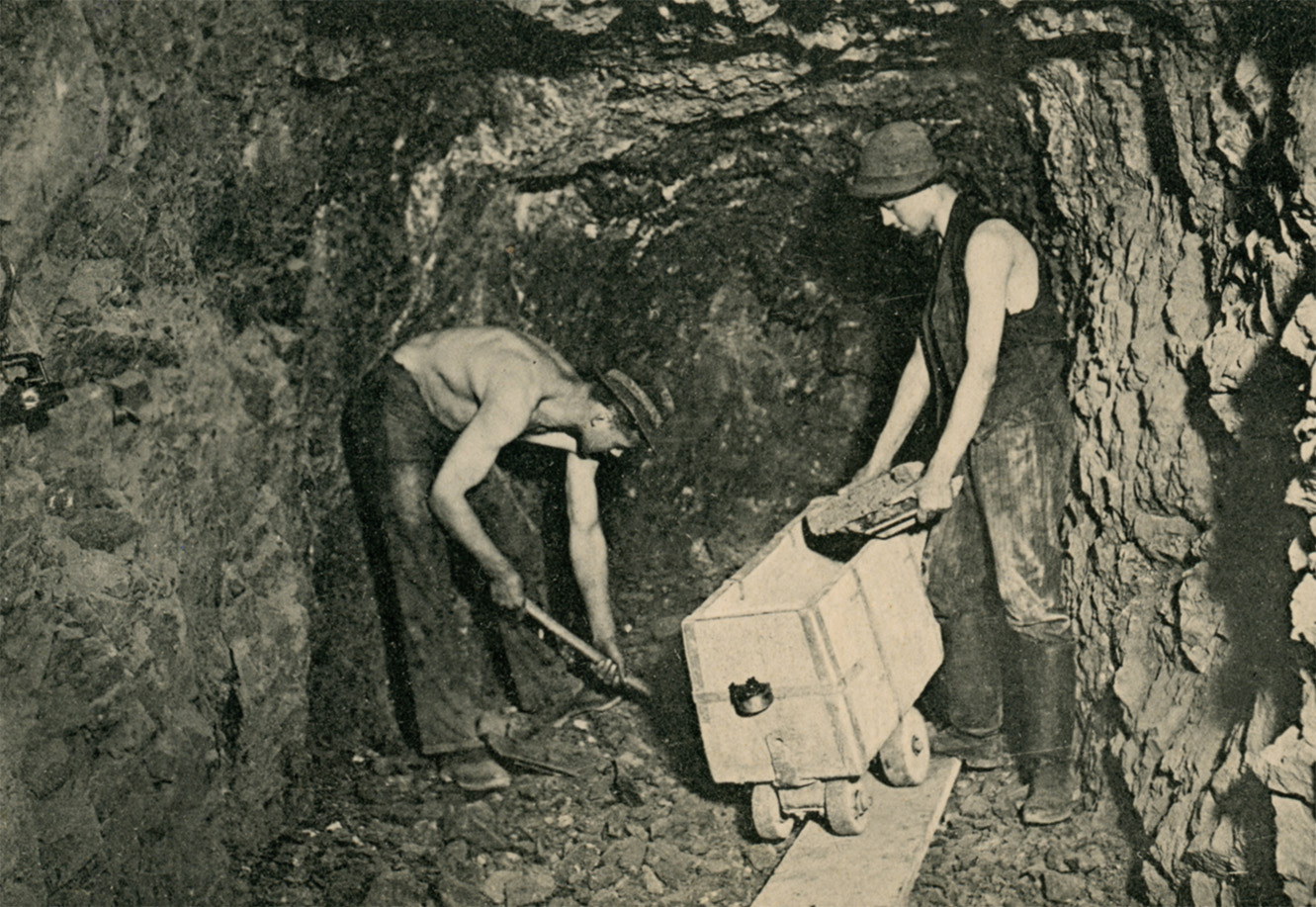
There are also several closed mines in Slovenia that may be worth exploring, adds Teran. For instance, the lead and zinc Mine in Mežica that contains germanium, which is used in infrared optics, solar cells, and high-speed electronic components; or the Sitarjevec mine in Litija known for barite which is widely used in plastics industry. However, he cautions, “reopening a mine is a lengthy process, often spanning a decade and requiring substantial research and financial investment.”
There are other challenges, too. The relatively low REE content in many deposits compared to global standards makes economic extraction challenging. Moreover, there are significant concerns about environmental impacts and societal acceptance of mining activities. Gaining a “Social License to Operate” will be crucial for the success of these projects.
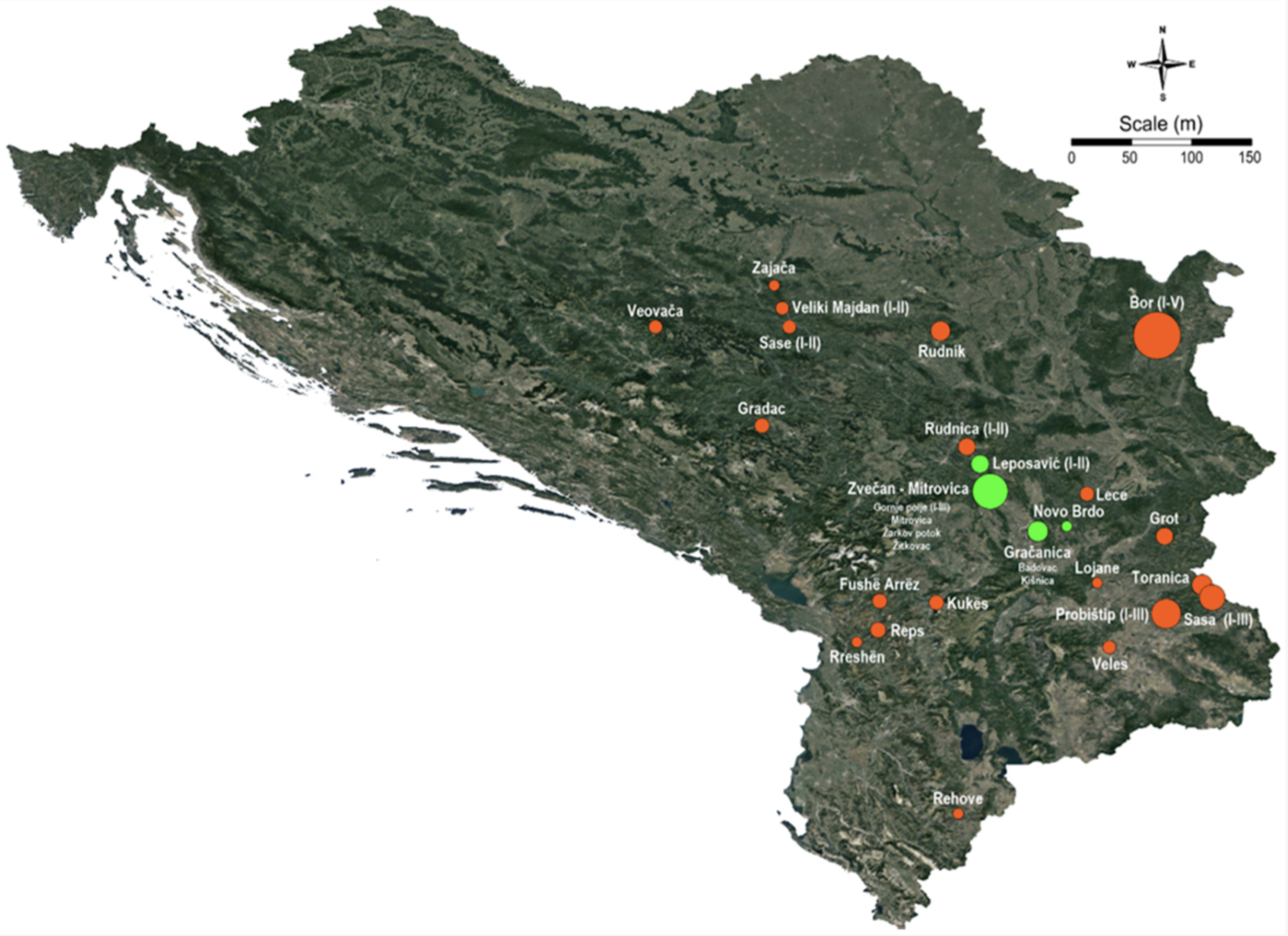
Locations of potentially prospective landfills – the size of the circle is proportional to the size of the SRM deposit. Source: www.mdpi.com
Rare opportunity
Despite these hurdles, the EU sees the Western Balkans as a key piece in its strategy to secure a stable supply of critical raw materials. The recently passed Critical Raw Materials Act (CRMA) sets ambitious targets for domestic sourcing and processing of these materials, and the Western Balkans could play a significant role in meeting these goals.
Initiatives like the RESEERVE project are paving the way for future development. By mapping mineral resources in the Western Balkans and creating a comprehensive mineral register, the project is integrating the region into a pan-European minerals intelligence network.
On a broader scale, the establishment of the Geological Service for Europe (GSEU) is underway, with active participation from the region. Slovenia is set to become the formal holder of the International Centre of Excellence for Sustainable Resource Management, further cementing the region’s role in Europe’s mineral resource strategy.
This would not only contribute to Europe’s REE supply chain but also boost local economies. Professor Vladimir Simić from the University of Belgrade’s Faculty of Mining and Geology emphasises the broader implications of this development.
“The Western Balkans must reindustrialise to survive,” he argues. “By industrialisation, I mean modern factories with zero CO2 emissions, competitive products, and well-paid workers. The Western Balkans could serve as a good example, showing that cooperation between states can be highly successful when the right goals are set.”
THE ADRIATIC
Not only what we measure, but also how we measure
editor
Barbara Matijašič
Leadership in Healthcare Amidst New Technologies was the focus of a recent international conference hosted in Bled, Slovenia. Organised by IEDC-Business School and the Bled Institute for Leadership in Digital Transformation and Artificial Intelligence (BILDAI) as well as supported by Slovenian Ministries of Health and Digital Transformation, along with the Medical Chamber of Slovenia, the event hosted an impressive lineup of speakers, while discussions were intertwined with ambition and motivation for change.
Public health systems across Europe are not in good shape, previously described by OECD as “underprepared, understaffed and facing underinvestment”. Slovenia is not immune to these issues. Like other countries, we face an aging population, increasing numbers of patients with chronic diseases, and a shortage of healthcare workers. Health Insurance Institute of Slovenia last weeks’ statistics are again alarming: only 69 or 7.3% of family medicine clinics are accepting new patients (compared to 95 or about 10% last July). On 31 May 2024, 136,754 people in Slovenia were without a doctor – this is a little less than 10% of the whole population.
The solutions discussed centered around new models that prioritize preventing health problems, promoting wellbeing, and providing value-based healthcare, shifting away from only treating illness. Patient involvement and citizen motivation were also emphasized. Now is the time to take advantage of digital technologies and for policymakers and industry to act together.
In light of this, the importance of measurement cannot be overstated. Yet, not only what we measure, but also how we measure it is key – a principle derived from the Father of Management, Peter Drucker’s popular quote, You can’t manage what you can’t measure. Although Drucker never actually said it, the importance of setting clear and measurable goals with accurate inputs cannot be overstated. It is crucial for evaluating strategies, tracking progress, and making effective data-driven decisions.
Understanding not only what we measure but also how we measure is also vital within the framework of Value-Based Healthcare (VBHC), which Slovenia is slowly embracing. Prioritizing results over inputs and focusing on broader value for the patient, rather than just individual outcomes or findings, is key. Successful implementation of VBHC demands a holistic approach, including defining appropriate indicators, measuring costs, collecting data, and adjusting the financing. Collaboration among all stakeholders – patients, providers, and payer – is essential to defining success. In the words of a conference speaker, “Difficulty lies not in the new ideas, but in escaping the old ones.”
THE ADRIATIC
Next-gen transport connectivity
editor
As many of us head towards the Adriatic shores, navigating potential traffic jams is always a concern. Having real-time traffic updates would certainly come in handy, wouldn't it? Knowing the optimal departure time (and definitely not at 2 am!), which border crossings to avoid, and receiving instant alerts about accidents would not only increase our safety but also make our journeys more enjoyable.
By Maja Dragovic
This is where 5G technology steps in to streamline traffic management. And Telemach Slovenia has teamed up with Telemach Croatia, DARS, the University of Ljubljana’s Faculty of Electrical Engineering, and Croatia’s OIV in the 5G Adria project that aims to redefine transportation and connectivity along the Mediterranean corridor linking Slovenia and Croatia.
“The 5G Adria project opens a new chapter in our thinking, fostering cross-border collaboration and innovation while laying the groundwork for progress in the digital age,” explains Tomislav Čizmić, CEO of Telemach Slovenia. “It’s not just about technological advancement; it’s about broader social and economic development in our region. The 5G network will become the backbone of digital infrastructure, connecting our countries in new and innovative ways. This study will positively impact the entire region, laying the foundation for future cross-border cooperation in technology and economy,” he concludes.
Under the Connecting Europe Facility (CEF) – Digital (CEFDigital), the project explored the feasibility of introducing connected and automated mobility (CAM) with enhanced traffic information and management. It focused on enhancing safety, traffic flow, and vehicle communication through dense 5G network coverage, high data transmission capacity, low service latency, and high reliability.
“At DARS, we are excited to contribute to a project that offers new opportunities in advanced digital communication technologies,” says Ulrich Zorin, Head of New Technology Development at DARS. “Robust coverage of DARS-managed road networks with a 5G mobile network will enable faster, more reliable communication, data transfer between traffic management systems and highway users, and real-time video streaming. Participating in the 5G Adria project allows DARS to assess current network coverage and develop strategies to enhance highway coverage with 5G mobile signals.”
Foundation for smart mobility
The research lays the groundwork for high-performance networks capable of supporting advanced applications for safe and efficient autonomous vehicle operations. It also addresses various aspects such as e-health, mobility, e-mobility, transportation, industry, smart society, and smart cities, with a strong emphasis on sustainable development aimed at reducing CO2 emissions and fostering a cleaner environment through improved traffic infrastructure.
“At the Faculty of Electrical Engineering, University of Ljubljana, we take pride in shaping the future through the 5G Adria project,” says Dr. Tomi Mlinar. “While we cannot predict the future, our decisions are informed by current research. The study explores three scenarios for 5G network development to support present and future services, alongside existing operational services that will coexist with 5G technologies and beyond. Researchers at UL FE are proud to contribute to the success of this collaborative project between two countries.”
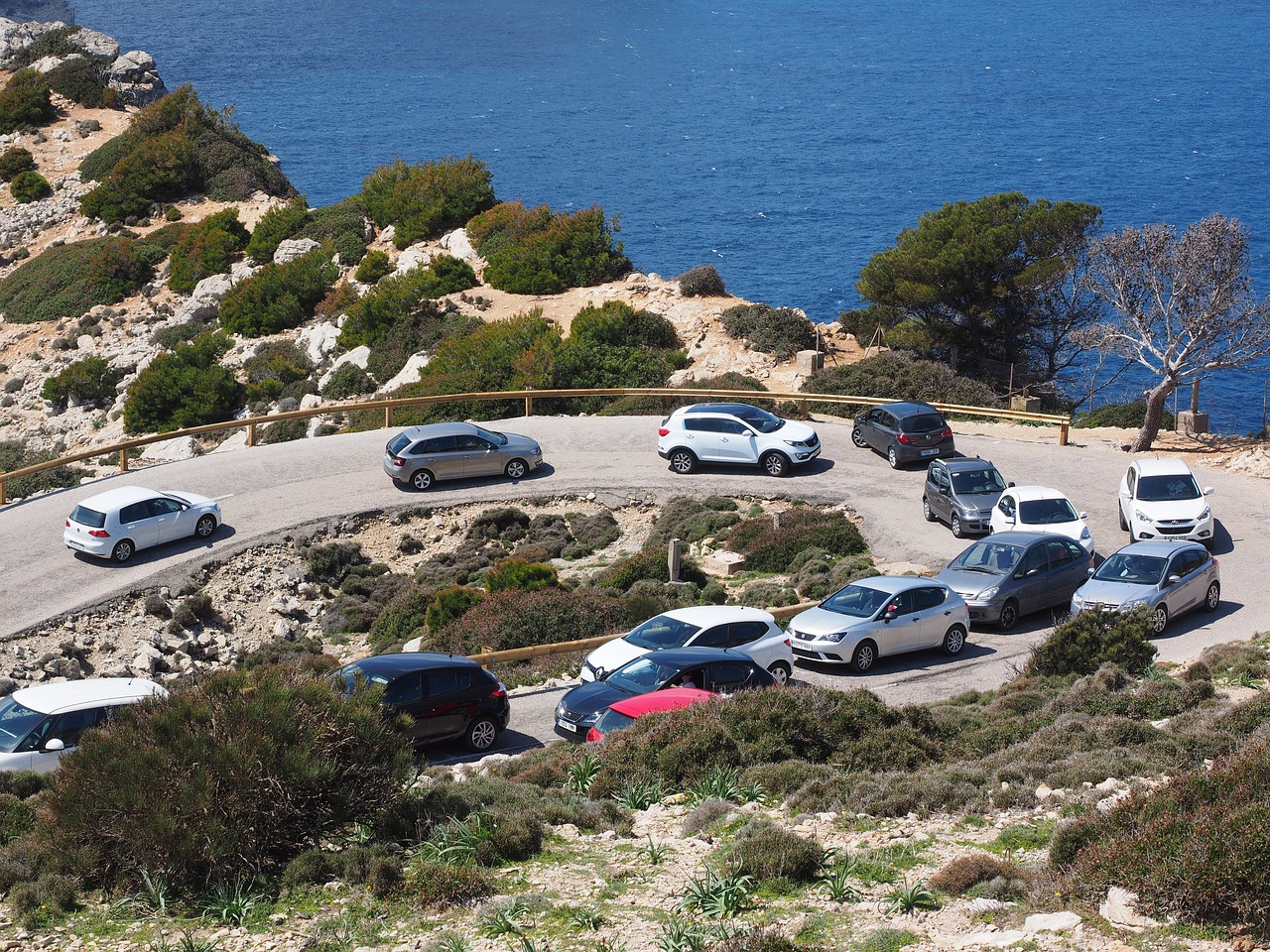
The study focused on establishing connectivity between the northern Adriatic ports of Koper and Rijeka, spanning 207 km in Slovenia and 171 km in Croatia. The project aims to outline replicable steps for other corridors in both countries.
“Achieving ambitious goals like those of the EU’s Digital Compass for digital transformation by 2030 necessitates projects like 5G Adria,” remarks Adrian Ježina, CEO of Telemach Croatia. “Telemach is committed to driving positive change and creating a more connected, digitally advanced region. The study has already highlighted significant benefits from introducing a 5G corridor, including improved traffic and digital infrastructure and strengthened economic cooperation. Through innovative collaborations, we can contribute to building a digital and sustainable future,” he adds.
THE ADRIATIC
Winning in sports, winning in business
editor
This article has been created in partnership with SPIRIT Slovenia business development agency
Maja Dragovic
From the Tour de France to the NBA courts and soon Euro 2024, Slovenian athletes keep garnering global acclaim, boosting the country’s prestige and economic opportunities on the world stage. Luka Dončić’s prowess on the basketball court is a perfect example of how sports shine a spotlight on a nation. "He (Luka Dončić) has made us in touch with how wonderful Slovenia is —what a great place it is to live, to work, to play. We didn’t know that before we met Luka," said Cynt Marshall, managing director of the Dallas Mavericks basketball team.
From the Tour de France to the NBA courts and soon Euro 2024, Slovenian athletes keep garnering global acclaim, boosting the country’s prestige and economic opportunities on the world stage. Luka Dončić’s prowess on the basketball court is a perfect example of how sports shine a spotlight on a nation. "He (Luka Dončić) has made us in touch with how wonderful Slovenia is —what a great place it is to live, to work, to play. We didn’t know that before we met Luka," said Cynt Marshall, managing director of the Dallas Mavericks basketball team.
Historically, sports have played a crucial role in enhancing national prestige, as seen during the Cold War, where athletic achievements were a proxy for ideological supremacy. A study by Jan Haut, Jonathan Grix, Paul Michael Brannagan, and Ivo van Hilvoorde underscores that sporting victories contribute significantly to a nation’s international reputation. For example, 78.2% of Germans believe that Olympic medals boost Germany’s global image, a sentiment echoed by Canadians around the 2010 Winter Olympics.
Beyond pride
But the impact of sporting success goes beyond the national pride. In nations as small as Slovenia, it helps boost the country’s global recognition. Performances by Tadej Pogačar and Primož Roglič in cycling have been nothing short of spectacular, attracting attention in every corner of the globe. Lance Armstrong, former cyclist, remarked on their impact following the 2020 Tour de France: “A great day for Slovenia. I mean, I don’t even remember whether I’ve ever cycled with any Slovenes. I don’t even know where Slovenia is… They were first and second! A remarkable day for Slovenia!” Armstrong’s astonishment highlights the extent to which these athletes have brought Slovenia into the global spotlight.
Luka Dončić, the NBA star, has similarly elevated Slovenia’s recognition in the United States. “Our inspiration for building strong business and friendly ties between Slovenia and Texas is undoubtedly Luka Dončić, who has won the hearts of the locals and significantly raised Slovenia’s visibility”, said Ajša Vodnik, chair of AmChams in Europe.
Mega events as platforms for business
On the heels of sporting success, major sporting events also serve as strategic platforms for economic diplomacy and business promotion. On the sidelines of Dallas Mavericks games in the NBA, SPIRIT Slovenia business development agency, the Ministry for Economy, Sports and Tourism, AmCham Slovenia and other partners organised Texas Feels Slovenia event in Dallas in 2023 and 2024 where Slovenia showcased its potential as an investment destination. More than 170 participants from a number of leading American companies attended the events. Following the event this year, Rok Capl, director of Slovenia Business (SPIRIT Slovenia business development agency) said : “We are delighted that so many American participants attended and recognised us as an important business destination, both in terms of creating new partnerships and investment opportunities. We are very pleased with their response and their positive surprise at the opportunities our country has to offer, as this is a great endorsement of the efforts and many activities we are carrying out in the US market.”
The upcoming Euro 2024 offers similar opportunities. The match between Slovenia and Serbia in Munich on 19 June will be leveraged to showcase Slovenian businesses to a German audience. Multiple organisations that include Ministry of Economy, Sports and Tourism, together with SPIRIT Slovenia, the Football Association of Slovenia, with the support of the Slovenian Tourist Board, the Embassy of the Republic of Slovenia in Germany, the Consulate General of the Republic of Slovenia in Munich, and the Slovenian-German Chamber of Commerce have joined forces to organise a business event where almost 45 companies have registered to attend, including German automotive giant Mercedes Benz.
The link
So, the importance of FDI in an economy is quite clean maths – in Slovenia, it represents 34% of its GDP. And while it is difficult to put a number on the link between sporting success and economic benefits, there could be some indications. For example, the trade between Slovenia and the USA increased since Luka Dončić joined the Dallas Mavericks in 2018. Between 2020 and 2023, exports to the USA increased from just over EUR 560m to just over EUR 855m. A pure coincidence? Maybe, but could be considered.
Helping hand
And in the midst of all the international promotion of Slovenia’s quality business environment, quality workforce and high quality of life, is SPIRIT Slovenia business development agency and a one-stop shop for all businesses and investors coming to the country. From providing the latest investment opportunities online, to offering comprehensive advice and information from start to finish, the agency ensures foreign companies and investors are well informed and supported. Attracting investors is important. But keeping them in the country is even more and the agency has a separate program for FDIs already in the country to offer continuous support and guidance.The agency also awards the annual FDI of the Year to recognise significant contributors to the Slovenian economy.
THE ADRIATIC
Serbia and Slovenia push for deeper economic integration
editor
Jan Tomše
At last week’s business forum on economic cooperation between Slovenia and Serbia, business representatives from both countries discussed untapped opportunities in both markets. Drawing on their strong historical ties, the participants repeatedly emphasised the solid foundation that both countries need to build upon.
Serbia and Slovenia are not competitors, but rather complement each other and the potential for economic cooperation is immense. However, strengthening of business relations is still hindered by excessive administrative barriers. Therefore, the Western Balkans, where both countries have strong economic interests, should be opened as much as possible, agreed the participants of the event organised by the Institute for Strategic Solutions in cooperation with the Chamber of Commerce of Serbia, Spirit Slovenia the public agency, and the Slovenian Chamber of Commerce.
Tine Kračun, director of the Institute for Strategic Solutions, emphasised that good economic cooperation between Serbia and Slovenia could be strengthened by more intensive integration of Western Balkan countries into the European Union, starting with the establishment of a common economic zone as soon as possible. According to Ana Marković, a representative of the Chamber of Commerce of Serbia in Slovenia, there are about 2,000 companies with Serbian capital operating in Slovenia. Slovenian economic involvement in Serbia is also strong, as Slovenian companies employ more than 20,000 workers in Serbia, noted Matjaž Han, Minister of Economy, Tourism, and Sport. Tomislav Momirović, Minister of Domestic and Foreign Trade of the Republic of Serbia, added that Serbian entrepreneurs understand and are familiar with the business philosophy and habits of the Slovenian market. Today, he said, Serbia has a growing economy seeking opportunities in foreign markets, with 550,000 more jobs in Serbia now than a decade ago.
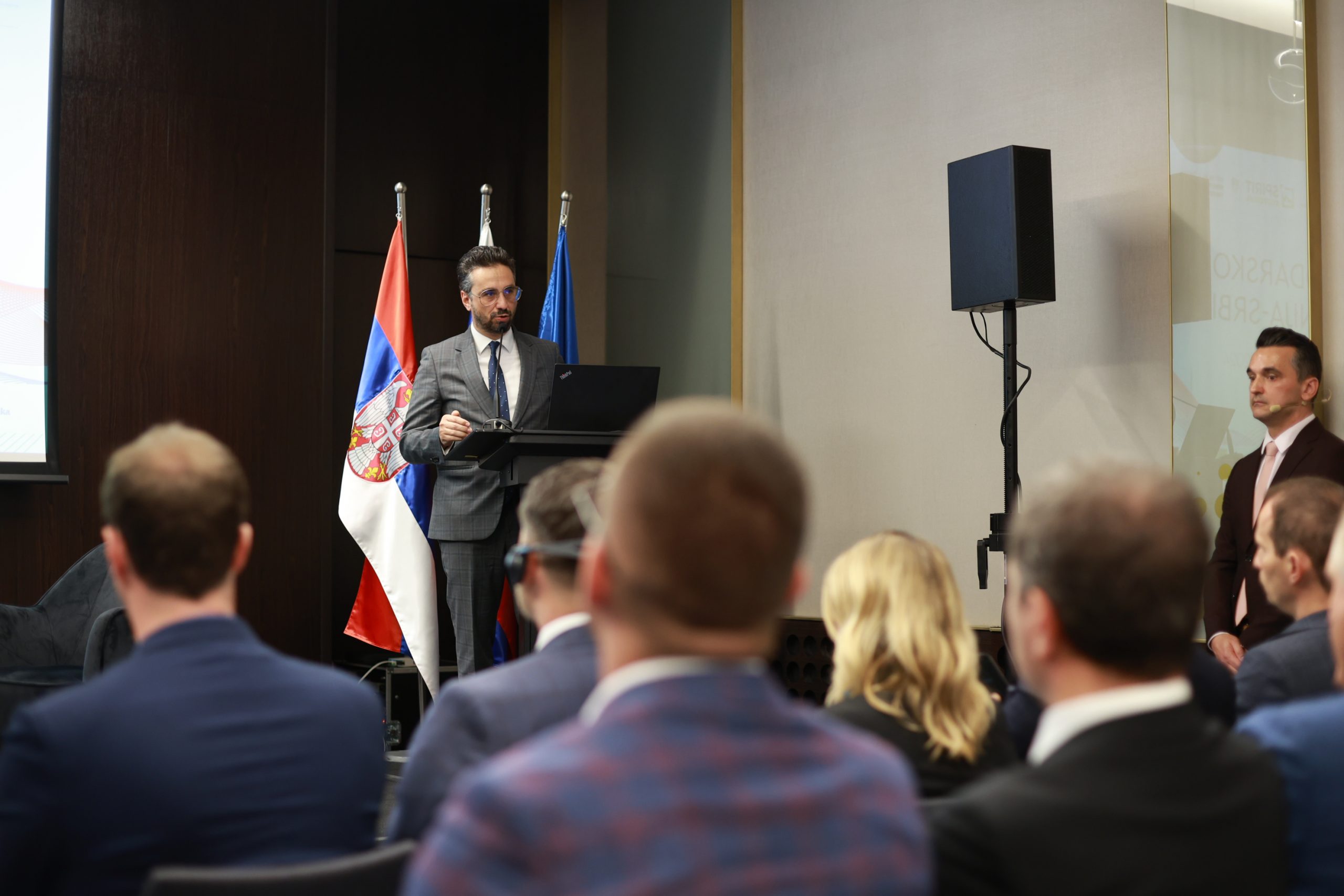
Tine Kračun, director of the Institute for Strategic Solutions, advocated for the establishment of the common economic zone as soon as possible.
Jure Stojan, partner and director of development and research at ISR, highlighted the role Serbian scientist Mihajlo Pupin played in ensuring that Bled remains part of Slovenia. After World War I, during the Paris Peace Conference in 1919, Pupin negotiated with the then American President Woodrow Wilson to have the territory of the western part of the Julian Alps, including Jesenice, Bled, Bohinj, and Triglav, which was initially intended to be annexed to Italy, incorporated into the then Kingdom of Serbs, Croats, and Slovenes. Stojan also summarised in a brief analysis that there are markets where Slovenians and Serbs are each other’s sole buyers or suppliers. From 2005 to 2020, Serbian exports to Slovenia increased from 94 to 408 thousand tons of goods annually, while Slovenian exports to Serbia rose from 117 to 307 thousand tons annually.
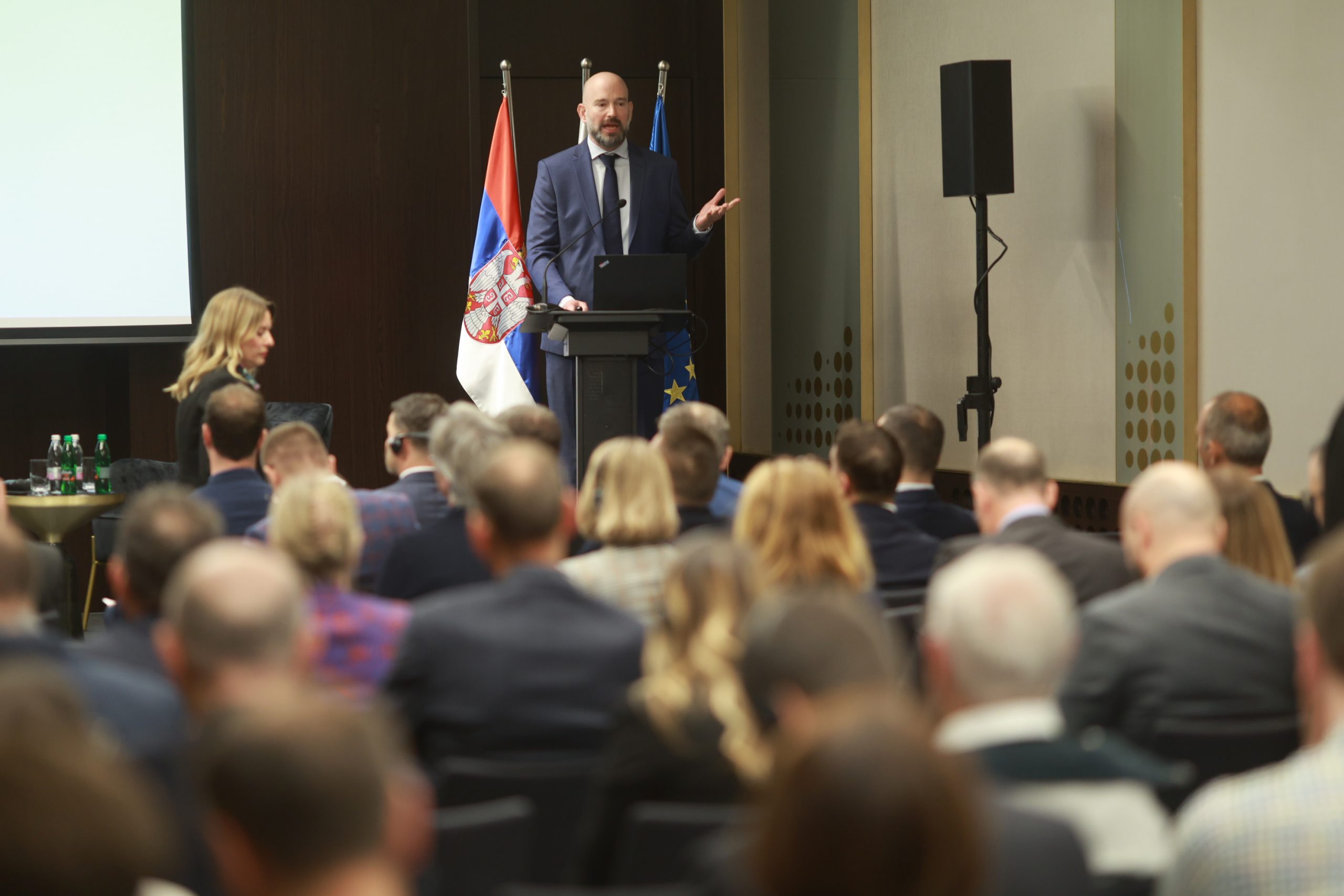
Jure Stojan, DPhil, highlighted the historical ties of the two countries through Mihajlo Pupin’s role in ensuring Bled remained within Slovenian borders.
Rok Capl, Director of the Spirit Slovenia public agency, pointed to the Slovenia’s strong points including the best combination of labour force in Europe, that is more affordable and more productive than in the West. Nikola Janović, Director of International Cooperation at the Serbian Development Agency, noted that Germany is the biggest investor in Serbia today, followed by Slovenian, Italian, and Austrian investments, with an increasing presence of Chinese investments.
Where and how to invest?
Željko Stašević, Director of Kempinski Palace in Portorož, observed that Slovenia’s tourist capacities are far from being fully utilised, especially in high-end tourism. Similarly, Vukajlo Babić, owner and director of the Serbian construction company Inobačko, believes that Slovenian and Serbian companies can jointly enter third markets. Uroš Čop, partner and director at the law firm Senica Andersen, finds that there are no major consulting firms in the region, which they see as an opportunity for business growth. They offer tax, legal, HR, and corporate consulting through a one-stop-shop approach. Their experience with Serbian partners has been exclusively positive, Čop said.
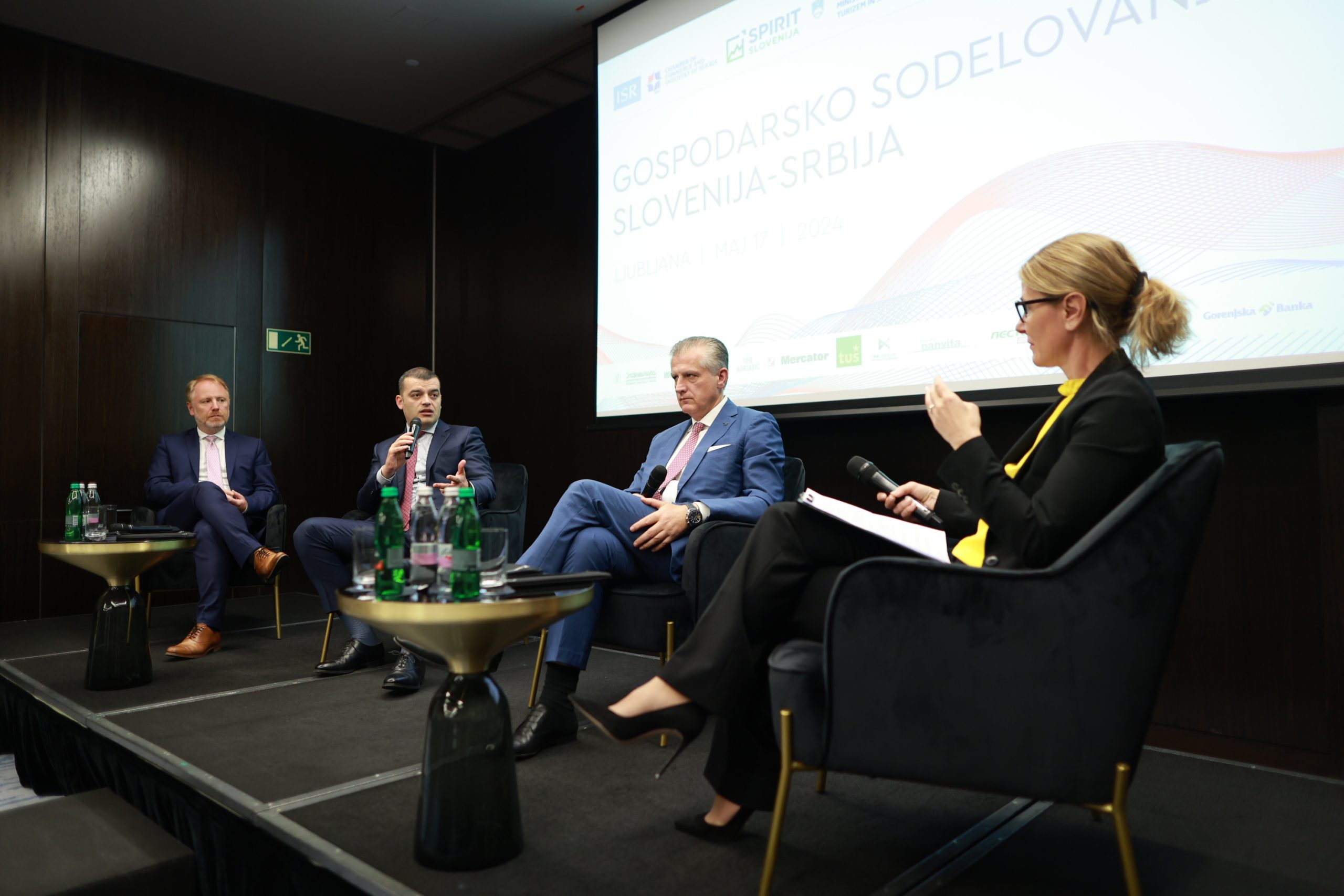
At the roundtable discussion moderated by Maja Dragovic, editor-in-chief of The Adriatic, the participants looked at the untapped business opportunities in Slovenia, particularly in tourism and construction.
Mariča Lah, President of the Slovenian Chamber of Commerce, stated that the chamber, as a representative association of the commerce sector, accounts for 32% of Slovenia’s GDP, with commerce employing 16% of the workforce. The potential of commerce in Slovenia exceeds EUR 35 billion, primarily in food and beverages, followed by energy products and personal vehicles and equipment. Toni Balažič, CEO of Panvita, noted the average Slovenian consumer visits five different stores weekly and is one of the most price-sensitive. Slovenia and Serbia are not competitors but complementary, Balažič said, adding that the competitors come from Spain, Greece, and other countries.
How to get on Slovenian store shelves?
Tomislav Kramarić, president of the management board of Mercator, illustrated consumer differences with the example of flour, which barely occupies a shelf in Western markets, while the number of shelves with flour in Eastern European countries is significantly larger. Similarly, he said, the demand for red meat is much higher in Serbia than in Slovenia, where consumers prefer white meat. Jože Smolič, a member of Petrol’s management board, believes that Slovenian consumers like Slovenian products but ultimately buy what is most affordable and high-quality.
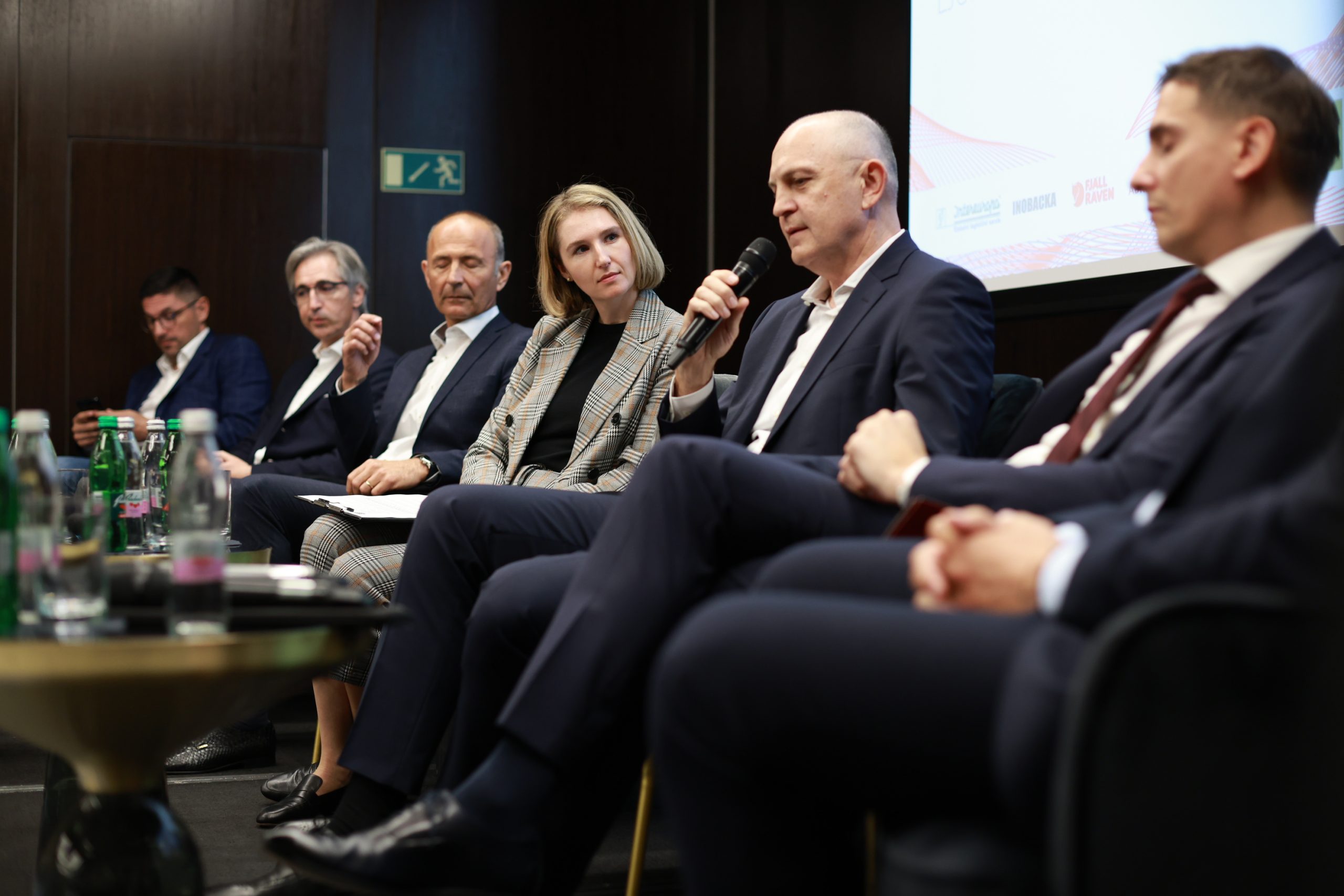
At the second roundtable discussion, moderated by ISR’s projects director Barbara Matijašič, participants looked at the differences between consumers in EU as well as across the southeast Europe.
Dušan Mitić, director at Tuš Slovenia, highlighted the travel time of products between Serbia and Slovenia, extended by border congestion, as a challenge for economic cooperation. Vukašin Petković, director of Corporate Affairs at Nectar Fructal Group, stated that cooperation is key when entering both markets. Bojan Knežević, CEO of Jaffa Crvenka, argued that focusing on continually new products that enhance the established offer is crucial when entering new markets. The differences between individual markets are significant, as illustrated by the diverse preferences of consumers in the UK, Germany, and Romania.
THE ADRIATIC
The Adriatic team has put together a brochure for the forum, highlighting the historical and business relations between Slovenia and Serbia. To access the full content click on the link.
Culinary meets diplomacy
editor
Nina Novak
An interview with Tomaž Kavčič, a renowned Slovenian chef and honorary consul of Serbia in Slovenia.
As the honorary consul of Serbia in Slovenia, how do you see the intertwining of the culinary traditions of both countries, and does this influence your culinary creations?
In everyday life, the influences of traditional Serbian cuisine in Slovenia may be more visible than those of Slovenian cuisine in Serbia, which has long operated in relative isolation, with the Orient having the greatest influence.
Traditional cuisine, and therefore gastronomy, in Slovenia, particularly in our region of Primorska, has always absorbed influences from Central European cuisine, with a distinct Germanic flavor enriched by Hungarian influences on one side. On the other side, it is influenced by Mediterranean cuisine, largely shaped by Venetian gastronomy, giving it a unique identity and authenticity. When Slovenia became part of a shared state, we embraced the culinary traditions from all parts of the former Yugoslavia, further enriching the cuisine of Primorska with these influences.
As I observe, this influence and blending of different cuisines from the broader region are not as evident in Serbia. However, Belgrade, a metropolis of two million people, is significantly more cosmopolitan and globally oriented in its gastronomy. I’m not referring to traditional Serbian cuisine, which is highly valued and sought after by visitors to Serbia, but to modern cuisine, which builds on local and seasonal principles, adapting preparation techniques to the basic goal of highlighting flavors and ingredients with minimal interference.
This approach is my guiding principle in culinary creation, which I want to share with my colleagues in Serbia. Fundamentally, I understand the role of honorary consul as that of a person who deeply respects the traditions of both nations. Cuisine is one of the foundations of tradition and the broader culture of a nation.
What is your philosophy regarding the use of local ingredients and traditional recipes?
My philosophy aligns with the fundamental principles of modern cuisine: local and seasonal. I’m fortunate to operate in a region where the Mediterranean, the Alps and Balkans meet, influenced by the Pannonian Plain. I work in a region shaped by over a thousand years of interaction between Germanic, Latin, and Slavic nations, where Austrian, Italian, and Slovenian cultures blend into a unique whole. These natural features have been passed down to me as a representative of the fourth generation of restaurateus in the Vipava Valley.
When the evening breeze enriches the Mediterranean aroma with essential oils from the Karst vegetation and the sun slowly sets where, viewed from the terrace of Zemono Mansion, the Alps descend to the plains towards the Adriatic Sea, my philosophy takes on a special dimension. Even when the cold bura wind blows everything far out to the open sea. When the wind calms down, a pleasant tranquility spreads again over the Vipava Valley. All of this forms the distinctive flavors of the produce and fruits of the land and waters, visible and palpable on the terrace of Zemono Mansion. We follow traditional recipes, constantly experimenting with new cooking techniques to highlight uniqueness and original flavor of produce.
How does your style differ from others, and what do you believe is the key to success?
My style is characterized by highlighting the fundamental flavors of the ingredients. I seek techniques that enable me to do this, either by refining them or sometimes creating my own. However, everything is based on the classical knowledge of cooking that I’ve gained from the tradition of four generations of restaurateurs—now slowly transitioning to the fifth.
It’s essential to understand that gastronomy is an integral part of hospitality, which encompasses much more than just food preparation. The essence of hospitality is guest satisfaction, ensuring they feel as comfortable as possible from the moment they enter our restaurant until they leave.
My style is also recognizable for its unique presentation and plate composition. Personal touches are evident in my culinary creations, distinguishing me from others.
How do you see the future of gastronomy in Slovenia, Serbia, and globally, and what role can gastronomy play in fostering collaboration and building strategic partnerships?
The future of gastronomy undoubtedly lies in respecting local and seasonal ingredients. We must not deviate from this almost overused phrase because gastronomy contributes to the most significant challenge of our times: reducing global warming. By strictly adhering to the principles of local and seasonal ingredients, we can reduce the carbon footprint of gastronomy. However, reducing the carbon footprint is no longer enough today. We need to adapt to climate change, learn to live with it, and protect ourselves from its destructive consequences.
Top-quality gastronomy relies on premium ingredients produced by local farmers and winemakers, who are increasingly impacted by global warming. Without protecting local producers from the adverse effects of increasingly aggressive natural disasters, high-end gastronomy will not be possible in the future.
Gastronomy in Slovenia, Serbia, and globally will need to work more closely with food producers and establish patterns of collaboration and operation that will ensure effective responses to the consequences of global warming at the local level. This represents one of the biggest challenges in building strategic partnerships.
Since high-end gastronomy always entwines personal and business connections, its strategic importance is also significant in this regard. We just need to harness it properly.
How does your work as an honorary consul influence your culinary creations, and conversely, how does your culinary expertise affect your role as a consul?
The title “honorary” reveals that this is not a professional role. My profession is gastronomy and, broadly speaking, hospitality. My knowledge in this field has little in common with my role as an honorary consul. However, gastronomy and hospitality are based on daily interaction and communication with people from different professions, backgrounds, and social statuses. This breadth has given me the ability to understand and accept individuals, diverse perspectives, and opinions from the local to the global level. It’s what helps me the most in effectively and correctly fulfilling my role as honorary consul.
I took on this role because I believe that Slovenia and Serbia can build on their traditionally good cooperation, especially the positive human relationships woven through business, family, and friendship ties across many historical periods and various challenges in interpersonal, interstate, and international relations.
I am honored to bring Serbia closer to Slovenia and Slovenia to Serbia, seeking opportunities for cooperation at all levels of society, starting with the economy.
Only direct and friendly communication enables understanding and recognition of diversity, which enriches us and does not divide or cause resentment and negativity.
By nature, I am an optimist, which was undoubtedly one of the reasons I accepted the role. I always infuse this optimism into the relations between Serbia and Slovenia in my role as honorary consul.
What has been the most unexpected or inspiring experience you’ve had throughout your career, and how did it affect your work?
Every working day brings something unexpected yet inspiring. When EU member state prime ministers gathered at Brdo pri Kranju during Slovenia’s recent EU presidency, German Chancellor Angela Merkel was particularly delighted with the dessert. Despite protocol, which usually does not allow this, she requested a second serving and invited me to her table to compliment and thank me in front of everyone.
We often host well-known figures from the worlds of sports, entertainment, and business at Zemono. We are direct and warm with them, just as we are with everyday guests—almost like friends but with respectful distance. Like all other guests, they must feel as comfortable as possible and leave with the best memories.
During the recent Milan Design Week 2024, Azimut Yachts selected me to prepare the reception for their prestigious event. We share values regarding creativity and worldview. Their newest vessel is entirely made from natural materials, aligning with my commitment to the principle of local and seasonal. When a company like this recognizes your work by engaging you for such a significant business event, it is definitely an inspiring experience.
Moments like these give me energy for further work. As long as I believe they will continue to happen, I will persist in this profession, which is magical in its own way, filling me with life satisfaction and a sense of achievement. I could write a book about all of this. Perhaps I will.
THE ADRIATIC
I am text block. Click edit button to change this text. Lorem ipsum dolor sit amet, consectetur adipiscing elit. Ut elit tellus, luctus nec ullamcorper mattis, pulvinar dapibus leo.
The forgotten pioneer of a popular form of data visualisation
editor
Jure Stojan, DPhil
“Sparklines are small, intense, word-sized graphics with typographic resolution”, writes Edward Tufte, a guru of data visualization and information design. He is also widely recognized as the father of sparklines, outlining their core principle (“Graphics can be shrunk way down”) in his 1983 textbook The Visual Display of Quantitative Information.
Sparklines also led to a clash between Tufte and Microsoft when the software company tried to patent the concept in 2008. This form of visualisation is typically used to present trends and variations associated with some measurement (such as financial market movements or patient vital signs). Unlike typical charts, sparklines are meant to be grouped together or embedded in text, allowing for efficient communication of data trends and patterns without the need for detailed analysis.
Interestingly, an early precursor to sparklines can be traced back to the work of Arthur Schwäger Freiherr von Hohenbruck (1837–1902), an Austrian aristocrat (baron) and botanist (today, the gentleman is mostly remembered as the husband of the women’s rights activist Prisca von Hohenbruck). In an article of 1898, von Hohenbruck used small bar charts within the cells of a larger statistical table, comparing the yield of the 1897 wheat harvest with the average of the preceding ten years.
From a quick analysis of the data visualisation, one can observe that there are differences in the wheat production across different regions of the Austrian crownlands. These included several parts of the Adriatic (Krain – Carniola, now a major part of Slovenia; Görz – Gorizia, a region named after a border town in what is today Italy but otherwise shared with Slovenia; Istrien – Istria, currently divided between Italy, Croatia, and Slovenia; as well as Dalmatien – Dalmatia, now part of Croatia). Despite the varied and sometimes quite productive yields of these individual regions, their combined contribution was a small fraction of Austria’s total yield, highlighting the vast agricultural output of the other regions within the empire.
Source: Statistische Monatsschrift (the official organ of the Statistische Zentralkommission, the Imperial-and-Royal Statistical Commission), January 1898
THE ADRIATIC
This article was originally published in The Adriatic Journal: Strategic Foresight 2024
If you want a copy, please contact us at info@adriaticjournal.com.
Enhancing healthcare productivity and resilience
editor
The Adriatic team
The Society of Healthcare Economists in Slovenia convened last week to address critical issues plaguing the country’s healthcare sector. Central to the conference’s discussions was the imperative to monitor and evaluate the productivity of healthcare providers comprehensively. Participants advocated for a dual approach, focusing on both individual practitioners and multidisciplinary teams. This, it was argued, would offer a nuanced understanding of healthcare delivery efficiency from various perspectives.
The Society of Healthcare Economists in Slovenia convened last week to address critical issues plaguing the country’s healthcare sector. Central to the conference’s discussions was the imperative to monitor and evaluate the productivity of healthcare providers comprehensively. Participants advocated for a dual approach, focusing on both individual practitioners and multidisciplinary teams. This, it was argued, would offer a nuanced understanding of healthcare delivery efficiency from various perspectives.
In her welcoming speech, the president of the society, Helena Ulčar Šumčić, emphasised the importance of establishing a resilient healthcare system capable of effectively responding to crises. Recognising that a shortage of human resources undermines the system’s responsiveness, she said the investments in infrastructure, equipment, and digital technologies are pivotal to bolster resilience.
Legislative reforms also featured prominently in the discussions. The health minister Dr. Valentina Prevolnik Rupel pointed out that four laws and a number of subsidiary acts have been adopted during her short tenure, but more is needed. She stressed the need for all stakeholders to collaborate to ensure the efficiency of the healthcare system.
Participants called for amendments to current laws to regulate physicians’ employment, particularly within the public sector, emphasising tripartite agreements (both institutions and employees) and unified pricing for services in the public interest. Additionally, the need for regulatory frameworks governing wages, sick leaves, and flexible remuneration to ensure fair and efficient employment practices were also highlighted.
Another key tenet of the discussions was the pivotal role of motivated, competent workers across all generations. Participants advocated for intergenerational knowledge transfer and cooperation to harness the full potential of healthcare personnel.
To ensure financial sustainability, redefining the relationship between healthcare financing sources and optimizing the scope of rights funded from public funds was also proposed. Speakers stressed the importance of systemic changes to curb rising absenteeism and underscore the significance of effective implementation and evaluation mechanisms for healthcare policies and programs.
Furthermore, participants highlighted the importance of strategic planning, effective investment management, and clear project guidelines for successful implementation of healthcare investments. They advocated for a robust secondary network of public healthcare aligned with population needs and existing capacities.
Importantly, the debates at the conference challenged the notion that positive business outcomes alone should define the success of healthcare directors. They contended that factors such as service types, payment structures, and patient complexity must also be considered.
In navigating the ongoing healthcare crisis, the conference participants emphasised the need for shared goals, clear vision, and strengthened regulatory oversight. It was argued that these strategies are fundamental to steering the healthcare sector towards greater productivity, resilience, and success. Consequently, the role of the system regulator needs to be strengthened.





